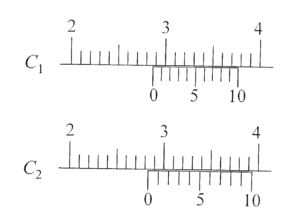EASY
Earn 100
What is the difference between microns and micrometers?
Important Questions on Measurement and Physics
EASY
MEDIUM
EASY
EASY
MEDIUM
The readings of the main scale and the circular scale, for a thin sheet, are and respectively, the thickness of this sheet is:
HARD
MEDIUM
EASY
MEDIUM
| S.No. | MS (cm) | VS divisions |
| 1. | 0.5 | 8 |
| 2. | 0.5 | 4 |
| 3. | 0.5 | 6 |
If the zero error is - 0.03 cm, then mean corrected diameter is:
HARD
MEDIUM
HARD
There are two vernier calipers both of which have divided into equal divisions on the main scale. The Vernier scale of one of the calipers has equal divisions that correspond to main scale divisions. The Vernier scale of the other caliper has equal divisions that correspond to main scale divisions. The readings of the two calipers are shown in the figure. The measured values (in ) by calipers and respectively, are

MEDIUM
EASY
HARD
MEDIUM
EASY
EASY
MEDIUM
EASY

